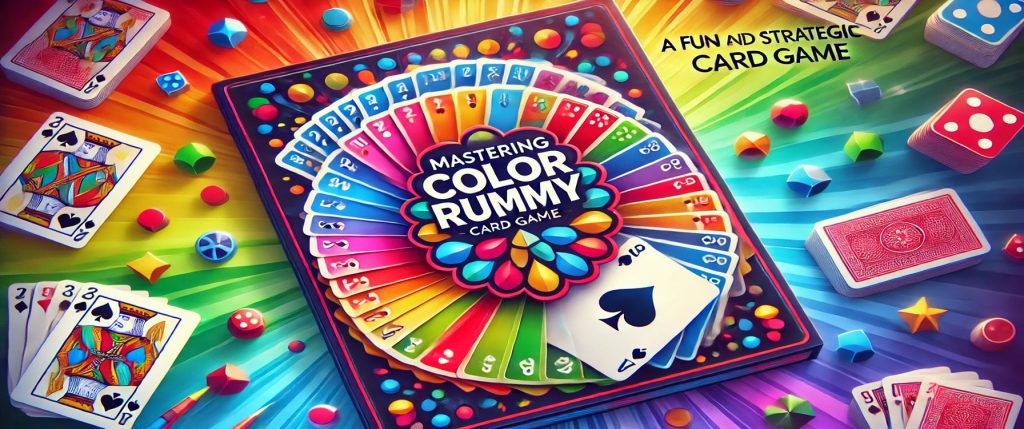Description

Color Rummy: A Complete Guide Color Rummy is a fascinating card game that has become popular with players of all ages because it combines skill, strategy, & a little bit of luck. Color Rummy, which is based on the traditional Rummy family of games, adds a lively twist by integrating colors into the gameplay, which makes it both visually appealing and captivating. Usually played with a standard deck of cards, the game can be enhanced with colored cards or tokens.
It usually involves two to six players. Players are kept on their toes by the thrilling challenge of forming sets and runs with cards of the same color or rank. Color Rummy’s appeal stems from both its complex strategy and its simple rules.
In order to anticipate their opponents’ strategies and modify their gameplay accordingly, players need to think critically about their moves. It is the perfect option for family get-togethers, game nights with friends, or even casual online play because of its lively interaction, which creates a friendly yet competitive environment. As players gain more experience, they frequently learn new strategies & techniques that improve their Color Rummy enjoyment and skill. Both novice and expert players must comprehend the Color Rummy rules.
Depending on the number of players, each player is dealt a certain number of cards at the start of the game, usually seven or ten. When the top card is positioned face-up, the discard pile begins, and the remaining cards form a draw pile. Each player draws a card from the draw or discard pile, after which they discard one card from their hand.
The objective is to produce legitimate sets & runs, which are made up of three or more consecutive cards of the same color or three or more cards of the same rank. Players need to know how the game is scored in addition to forming sets & runs. When a player goes out by creating valid combinations, points are awarded according to how many cards are still in each player’s hand. Making the decision of which cards to keep or discard requires additional strategy because face cards, for example, may have higher point values than numbered cards. A flexible option for different play styles & time constraints, the game lasts until a predefined score is reached or until players choose to end the session.
Beyond just forming sets & runs, mastering Color Rummy necessitates a deep comprehension of strategy. Card observation is a basic component; players should closely monitor the cards their opponents draw and discard. This awareness can help players strategically block—that is, discard cards that could help opponents finish their sets—by giving them important information about the combinations that other players are trying to make.
Players should also think about how their hands are put together and focus on creating combinations that will increase their chances of going out while lowering the possibility that they will leave high-point cards in their hand. Effective hand management during the game is another crucial strategic component. Players should try to keep a variety of high- and low-value cards in order to preserve flexibility. This will allow them to form combinations & minimize the number of points they could lose if another player leaves the game. Also, timing is vital; understanding when to leave can be just as significant as understanding how to form sets. Gamers have to balance the advantages of leaving early against the possibility of earning more points through extra play.
Color Rummy is a game of opportunity as well as deft decision-making because of this fine balance between attack and defense. There are a few useful hints that players can use to improve their Color Rummy experience and really succeed at the game. The most important thing is to cultivate a keen sense of observation. You can learn about your opponents’ strategies and modify your own by keeping a careful eye on both your own and their hands.
For example, it might be prudent to refrain from discarding cards that your opponent frequently picks up in order to keep them from finishing their sets. This degree of focus has the potential to greatly affect how the game turns out. Another important piece of advice is to discard cards with patience and restraint. It could be tempting to throw away high-point cards right away in an attempt to go out sooner, but doing so carelessly can backfire. As an alternative, periodically assess your hand and decide which cards to keep & which to discard.
You may occasionally have more options for later combination formation if you hold onto a card for an additional turn. Increasing your chances of winning at Color Rummy can be achieved by developing a strategic mindset & paying attention to your choices. Even experienced players may make common Color Rummy mistakes that impair their performance. One common mistake is not modifying one’s approach in response to the changing game dynamics.
The game’s landscape is constantly shifting as players draw and discard cards; following a strict plan without reevaluating can result in lost opportunities or needless losses. It’s important to maintain flexibility and modify your strategy as necessary, whether that entails switching up your target sets depending on what’s available or refocusing your attention on a different color. Players frequently make the error of undervaluing the significance of defensive play.
Although winning requires forming sets and runs, it can be harmful to ignore what your opponents are doing. It is a common mistake that can give opponents an advantage to discard cards that might help others finish their combinations. To combat this, you should always plan ahead. You should not only concentrate on your hand, but also consider how your actions may affect other people. You can improve your overall gameplay and raise your chances of winning by staying clear of these traps. A few sophisticated Color Rummy strategies can give players a competitive advantage if they want to improve their abilities beyond the fundamentals.
One such method is “card counting,” which entails recording which cards have been used or discarded during the course of the game. Keeping a mental count of these cards will help you anticipate what will be in the draw pile and decide which cards to pursue or avoid. Your ability to plan strategically & create winning combinations can both be greatly improved by this degree of awareness. Bluffing, a frequently overlooked element of card games like Color Rummy, is another sophisticated strategy. Occasionally discarding cards that could give opponents false information about your intentions or the makeup of your hand can throw them off balance.
If you secretly hold onto similar cards in your hand while discarding a card that appears to be essential for finishing a set, for instance, you may cause opponents to alter their plans based on erroneous assumptions. But it’s important to use bluffing sparingly because doing so too much can raise suspicions and prompt shrewd players to counter. To accommodate players of various tastes and skill levels, Color Rummy has spawned a plethora of variations that bring distinctive twists to the classic gameplay. “Joker Rummy,” a well-liked variant, adds wild cards to the mix. The fact that these jokers can form sets or runs in place of any card greatly expands the number of possible combinations and gives each round an exciting element of unpredictability.
As players plan around the use of wild cards while still following the fundamentals of Color Rummy, this variation promotes creativity in gameplay. “Speed Rummy,” which prioritizes fast-paced play & prompt decision-making, is another fascinating variation. Because players in this version have a limited amount of time to make their moves, the action-packed environment tests the reflexes and strategic thinking of even experienced players. Players in Speed Rummy frequently engage in more lively interactions as they compete against time and try to outsmart one another.
Within the well-known framework of Color Rummy, these variations not only keep the game interesting but also let players experiment with various facets of skill and strategy. Because it can be played in a variety of settings, color rummy is suitable for both informal get-togethers and more competitive settings. For people who prefer in-person interactions, family game nights or traditional board game cafes offer a great way to get friends or family together at a table for a fun game of Color Rummy. A lot of cafes even regularly host game nights where fans can get together with other gamers and play casual matches or tournaments. Apart from physical locations, online platforms have become well-liked substitutes for playing Color Rummy at home.
Digital versions of the game are available on a variety of websites and mobile applications, enabling players to challenge friends remotely or connect with people all over the world. These platforms frequently have settings that can be changed, allowing users to play with different variations or modify the rules to suit their preferences. Because of its captivating gameplay & strategic depth, Color Rummy remains a popular card game that unites people, whether played in person or online. To sum up, Color Rummy is a unique card game that blends aspects of social interaction, strategy, and observation. Enthusiasts can completely immerse themselves in this dynamic gaming experience by comprehending its rules, developing strategic skills, avoiding typical blunders, investigating sophisticated techniques, accepting variations, and locating appropriate play areas.
Color Rummy provides countless chances for enjoyment and skill development, regardless of your level of experience.



